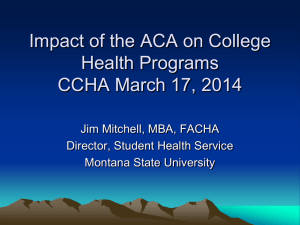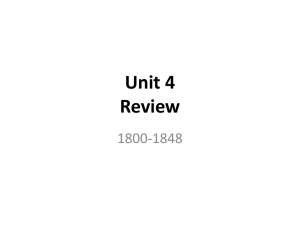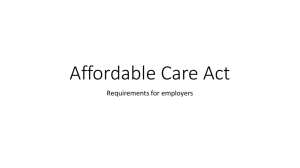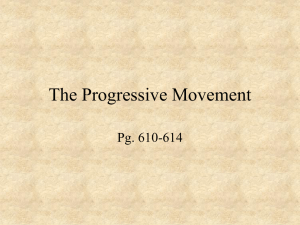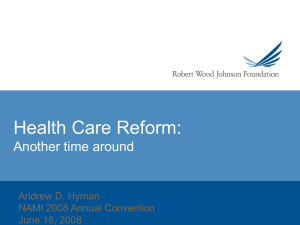Health Care Reform - Momentous Insurance Brokerage, Inc
advertisement
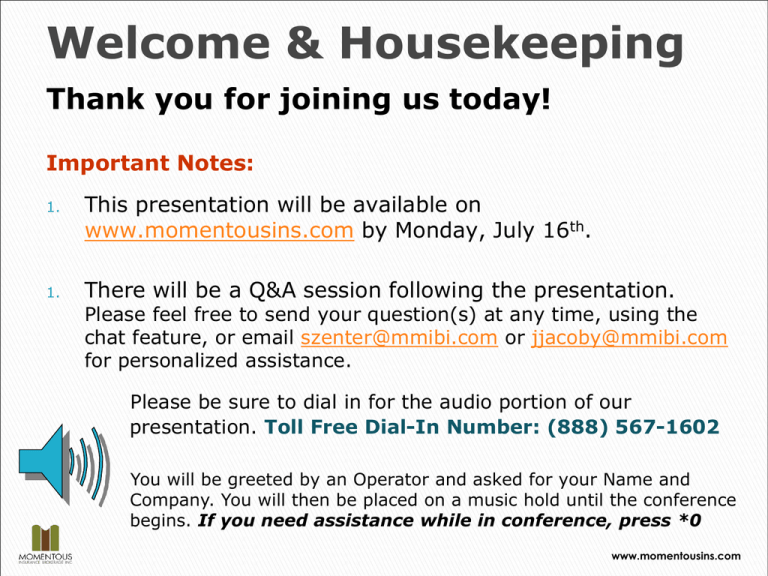
Welcome & Housekeeping Thank you for joining us today! Important Notes: 1. This presentation will be available on www.momentousins.com by Monday, July 16th. 1. There will be a Q&A session following the presentation. Please feel free to send your question(s) at any time, using the chat feature, or email szenter@mmibi.com or jjacoby@mmibi.com for personalized assistance. Please be sure to dial in for the audio portion of our presentation. Toll Free Dial-In Number: (888) 567-1602 You will be greeted by an Operator and asked for your Name and Company. You will then be placed on a music hold until the conference begins. If you need assistance while in conference, press *0 www.momentousins.com How The Supreme Court Ruling on Health Care Reform Impacts You Wednesday, July 11, 2012 Presented by: Sherrie Zenter, Senior Vice President Momentous Insurance Brokerage Jill Jacoby, Vice President Momentous Insurance Brokerage www.momentousins.com Mark Morgan, Vice President & General Manager Anthem Blue Cross – Small Group Agenda - Supreme Court Upholds Health Care Reform Law - What It Means for Individuals - What It Means for Employers - The Big Year “2014” with Mark Morgan - Questions & Answers www.momentousins.com Supreme Court Upholds Health Care Reform Law Health Care Reform What is It? • • Patient Protection and Affordable Care Act (PPACA) – signed on March 23, 2010 The health care reform law makes sweeping changes to our nation’s health care system to provide health coverage to ALL Americans effective 2014. www.momentousins.com Challenges to the Individual Mandate On June 28, 2012, the U.S. Supreme Court upheld the entire Affordable Care Act (ACA) as constitutional. The main issue in the case was whether Congress had the authority under the U.S. Constitution to enact ACA’s individual mandate that beginning in 2014 individuals will need to obtain health care coverage or pay a penalty. Opponents of the law argued that Congress exceeded its constitutional authority by enacting the individual mandate. Since the mandate is intertwined with the rest of ACA’s reforms, the law’s opponents also argued that the entire law should be struck down. www.momentousins.com Challenges to the Individual Mandate – Future Implications Because the individual mandate was upheld, all aspects of the health care reform law will remain in effect. Additionally, the remaining provisions of the health care reform law that are not currently in effect will continue to be implemented as planned. Many of the health care reform law’s provisions require agency guidance to be implemented. The Departments of Labor (DOL), Health and Human Services (HHS) and Treasury have been regularly issuing guidance to implement the health care reforms. These agencies will continue to promulgate regulations relating to the health care reform law. www.momentousins.com Challenges to the Individual Mandate –Future Implications Employers and health plans will be required to comply with these to the same extent that they are required to comply with the various provisions of the health care reform law. Although the Supreme Court held that the individual mandate is constitutional, opponents of the health care reform law may challenge other provisions using various legal arguments. If any further challenges arise, courts will address these accordingly. National Election in November can tilt the scales. www.momentousins.com Viewpoint - 6/28/12 • The Affordable Care Act (ACA) was largely upheld. • Penalty is now called a tax. • States can “opt out” to expand Medicaid Programs. • • What if it had been struck down? Back to square one with 50 million uninsured and a healthcare system that continues to increase. Difficult to obtain insurance in the current individual marketplace and the reason for so many uninsured (e.g., underwriting approval, rated or declined). New York individual rates averaging $1,400 per month for individual and $4,272 per month for family. www.momentousins.com Viewpoint - 6/28/12 ACA Affects on Individual Medical Insurance Market. What will 2014 Look Like? • No Medical Underwriting, Waiting Periods or Ratings. • Tax Penalties for individuals failing to Buy Coverage. • • • People won’t get coverage until they need it. Can an individual apply and get coverage before going to a doctor or hospital? Need to work on Modifying the Individual Market. As passed, Legislation began at 2700 Pages. By 2018 the final Legislation will expand to 250,000 Pages. www.momentousins.com Viewpoint - 6/28/12 Many tweaks needed for individual mandate to run smoothly: • • • Via open enrollment periods when someone can apply for coverage Carrier Flexibility in Offerings Make it tougher to apply if late or miss open enrollment window www.momentousins.com Supreme Court Ruling: What it Means for Employers Employers must continue to comply with ACA’s reforms ACA changes that have already been implemented will remain in effect, such as the requirement to cover adult children until age 26 and the requirement for non-grandfathered plans to cover certain preventive care services without cost-sharing. ACA’s provisions that are not currently in effect will continue to be implemented as planned. For example, effective for 2013 plan years, participants’ pre-tax contributions to health flexible spending accounts (FSAs) will be limited to $2,500 per year. www.momentousins.com Employers must continue to comply with ACA’s reforms While it is possible that changes will be made to ACA through future legislation or court rulings, ACA is the health care reform law currently in effect. Thus, employers should continue to prepare for ACA changes that become effective in 2012 and 2013. Employers should also keep in mind the ACA reforms that will take place in 2014. www.momentousins.com ACA REFORMS - 2012 AND 2013 Form W-2 Reporting Requirements Beginning with the 2012 tax year, large employers that are required to issue 250 or more W-2 Forms must report the aggregate cost of employersponsored group health coverage on employees’ W-2 Forms. The cost must be reported beginning with the 2012 W-2 Forms, which are due in January 2013. This requirement is optional for smaller employers for the 2012 tax year and until further guidance is issued. This reporting is for informational purposes only; it does not affect the taxability of benefits. www.momentousins.com ACA REFORMS - 2012 AND 2013 Women’s Preventive Care Services Effective for plan years starting on or after Aug. 1, 2012, non-grandfathered plans must cover specific preventive health services for women without cost-sharing, such as deductibles, co-payments and coinsurance. These services include well-woman visits, breastfeeding support, domestic violence screening, STD screening and contraceptives. Exceptions to the contraceptive coverage requirement apply to certain exempt religious employers. www.momentousins.com ACA REFORMS - 2012 AND 2013 Medical Loss Ratio Rebates Fully insured plans may receive rebates in August 2012 if they qualify for a rebate from their health insurance issuers due to the medical loss ratio (MLR) rules. The MLR rules require insurance companies to spend a certain percentage of premium dollars on medical care and health care quality improvement, rather than administrative costs. Employers may receive rebates from issuers in the form of a premium credit, lump-sum payment or premium holiday, if permissible under state law. Any portion of a rebate that is a plan asset must be used for the exclusive benefit of the plan’s participants and beneficiaries. This may include, for example, reducing participants’ premium payments. www.momentousins.com ACA REFORMS - 2012 AND 2013 Summary of Benefits and Coverage Plans and insurance issuers must provide a summary of benefits and coverage (SBC) to participants and beneficiaries. The SBC is intended to provide simple and consistent information about health plan benefits and coverage in plain language. Plans and issuers must provide the SBC to participants and beneficiaries who enroll or re-enroll during an open enrollment period beginning with the first day of the first open enrollment period that begins on or after Sept. 23, 2012. www.momentousins.com ACA REFORMS - 2012 AND 2013 FSA $2,500 Contribution Limit Effective for plan years beginning on or after Jan. 1, 2013, an employee’s salary reduction contributions to a health FSA offered under a cafeteria plan are limited to $2,500. www.momentousins.com ACA REFORMS - 2012 AND 2013 Elimination of Retiree Drug Subsidy Deduction Employers that receive the Medicare Part D retiree drug subsidy have been able to take a tax deduction for their prescription drug costs, including costs attributable to the subsidy. Also, these employers do not have to pay tax on the drug subsidy amount. Effective for 2013, the deduction for the retiree drug subsidy will be eliminated. www.momentousins.com ACA REFORMS - 2012 AND 2013 Additional Medicare Tax Withholding Effective Jan. 1, 2013, an additional 0.9% Medicare tax will apply to high-income individuals. Employers are required to withhold the additional Medicare tax on an employee’s wages in excess of $200,000 ($250,000 for married couples filing jointly). www.momentousins.com ACA REFORMS - 2012 AND 2013 Health Insurance Exchanges – Notice of Availability Employers must provide all new hires and current employees with a written notice about ACA’s health insurance Exchanges and the consequences if an employee decides to forgo employer-sponsored coverage and purchase a qualified health plan through an Exchange. This notice requirement generally becomes effective as of March 1, 2013. The Department of Health and Human Services (HHS) has indicated that it intends to issue model Exchange notices. More agency guidance is also expected on this notice requirement. www.momentousins.com ACA REFORMS - 2012 AND 2013 Nondiscrimination Rules for Fully Insured Plans Effective date delayed for regulations. Important to review each renewal date. Fully-insured plans must follow rules regarding nondiscrimination in favor of highly-compensated employees ◦ Cannot discriminate with respect to eligibility or benefits (e.g., Doesn’t allow for Class Carve-Outs. Must be consistent on contributions toward cost of insurance paid by Employer, etc.) Highly Compensated Employees (Testing Applies): ◦ 5 highest paid officers, more than 10% shareholder, or highest paid 25% of all employees www.momentousins.com ACA REFORMS – 2014 Additional ACA coverage mandates and reforms become effective in 2014. For example, group health plans may not: Impose pre-existing condition exclusions on any covered individual, regardless of the individual’s age; Have a waiting period for coverage that exceeds 90 days; or Apply any annual limits on essential health benefits. www.momentousins.com ACA REFORMS – 2014 ACA’s state-based insurance Exchanges are scheduled to be operational. Also in 2014, the individual mandate will become effective, as will ACA’s “pay or play” penalties for employers. Under the pay or play rules, certain employers with at least 50 full-time equivalent employees will face penalties if one or more of their full-time employees obtains a premium credit through an Exchange. An individual may be eligible for a premium credit either because the employer does not offer health care coverage or the employer offers coverage that is either not “affordable” or does not provide “minimum value.” www.momentousins.com Supreme Court Ruling: What it Means for Individuals Health Care Reform: What Does it Mean for You? How health care reform legislation affects you varies greatly depending on your age, who you work for and many other factors. So what does it mean for you? The following is a list of how health care reform affects a number of common categories. www.momentousins.com Health Care Reform: What Does it Mean for You? The 65+ now receive: Free preventive services under Medicare Once those with Medicare prescription drug coverage enter the “doughnut hole” coverage gap, they will be entitled to 50 percent off certain brand-name medications. Medicare beneficiaries earning $85,000 or more will pay higher Part B premiums until 2019. Those with Medicare Advantage plans may lose some benefits or experience an increase in copayments. www.momentousins.com Health Care Reform: What Does it Mean for You? Employees of a large company: Employers with 50 or more employees will be required to provide coverage or pay a penalty starting in 2014. Existing coverage packages will be grandfathered in, but new plans have to meet minimum requirements. www.momentousins.com Health Care Reform: What Does it Mean for You? Low-income employees: Even without children or a disability, those among the lowest-income workers will be eligible for Medicaid as of 2014. Those who earn less than 400 percent of the federal poverty level (about $88,000 for a family of four) will be eligible for subsidies to help buy coverage. The expansion of funding for community health centers, designed to offer free and reduced-cost care, will also provide relief. www.momentousins.com Health Care Reform: What Does it Mean for You? Children with a pre-existing condition: Group health plans and health insurance issuers may not impose exclusions on coverage for children with a pre-existing condition. Provision applies to all employer plans and new plans in the individual market. www.momentousins.com Health Care Reform: What Does it Mean for You? Adults with a pre-existing condition: Starting 2014, adults with pre-existing conditions will be able to obtain individual coverage through an insurance exchange. Insurers cannot place annual or lifetime limits on coverage, nor can they deny coverage or charge higher premiums due to a pre-existing condition. www.momentousins.com Health Care Reform: What Does it Mean for You? Unemployed and uninsured: Most individuals who are unemployed and uninsured likely qualify for Medicaid under the coverage expansion that began in 2010. The expansion of funding for community health centers, designed to offer free and reduced-cost care, will also provide relief. Certain uninsured individuals with pre-existing conditions can obtain coverage through the temporary high-risk pool as well (e.g., PCIP). www.momentousins.com Health Care Reform: What Does it Mean for You? Small-business owners: Organizations with 25 or fewer workers may be eligible for a tax credit to help provide coverage for employees (e.g., average annual wages of less than $50,000 per FTE). Those with 50 or more employees must provide benefits or incur a penalty tax starting in 2014. www.momentousins.com Health Care Reform: What Does it Mean for You? Young adults: Children may stay on their parents’ policies until age 26. www.momentousins.com The “Big Year” – 2014 Health Insurance Exchanges 2014 – Exchange Responsibilities Only Available in Exchanges • Subsidies for individuals from 133%-400% of FPL • Small employer tax credits Exchange Functions Operate a toll-free telephone hotline to help users Enroll applicants in their chosen plan Maintain a website to sell plans Work with federal and state agencies regarding subsidies and tax credits Enroll eligible individuals into Medicaid Set annual Open Enrollment Period and special Enrollment Periods Certify and rate plans www.momentousins.com 2014 – Product Framing Plus catastrophic plan offering for individuals younger than 30/financial hardship The benefit requirements listed above for exchange plans will also apply to Individual and small group fully insured plans sold outside of the exchanges www.momentousins.com 2014 – Questions Remain • What will the Exchange look like? • Will the Individual Exchange “work”? • • • • Will employers drop coverage and move employees into the Exchange? Small Group 2 – 100 Lives - 2016 Will the SHOP (Small Employer) Exchange “work”? Will Anthem Blue Cross be in the Exchange? www.momentousins.com Individual Responsibility • Jan. 1, 2014: Individuals must enroll in coverage or pay a tax penalty Penalty amount: • Greater of $ amount or a % of income – 2014 = $95 or 1% – 2015 = $325 or 2% – 2016 = $695 or 2.5% – Family penalty capped at 300% of the adult flat dollar penalty or “bronze” level premium www.momentousins.com Family Responsibility Penalty amount: Greater of $ amount or a % of income – 2014 = $285 or 1% – 2015 = $975 or 2% – 2016 = $2,085 or 2.5% – Family penalty capped at 300% of the adult flat dollar penalty or “bronze” level premium www.momentousins.com Health Care Reform Resources Momentous Provides Continued Updated Resources www.momentousins.com The U.S. Department of Health and Human Services maintains a website: www.HealthCare.gov The White House Website http://www.whitehouse.gov/healthreform California PCIP is available at: www.pcip.ca.gov/Home/default.aspx California Health Benefit Exchange is available at: www.healthexchange.ca.gov/Pages/Default.aspx www.momentousins.com Additional Resources Posted on www.momentousins.com By Monday, July 16th Today’s PowerPoint Presentation Health Care Reform Timeline 2010 – 2018 Medical Loss Ratio Rules Health Care Reform: General Q&A for Employers State of Employment Laws California – Health Care Reform Health Care Reform: Who, What, When IRS Provides Guidance on $2,500 Health FSA Limit effective January 1, 2013 Health Care Reform: Common Acronyms www.momentousins.com Questions? Please feel free to ask now and/or contact Momentous directly at: Sherrie Zenter szenter@mmibi.com P: 818-933-2739 Jill Jacoby jjacoby@mmibi.com P: 818-933-2778 www.momentousins.com


